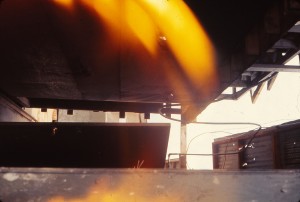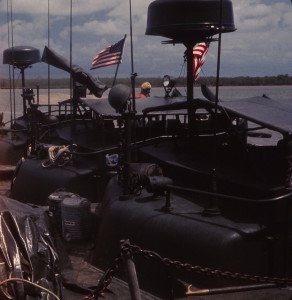There are many tragedies in warfare but some of the most tragic, because they are frequently avoidable, are deaths or injury caused by the (oxymoron) “friendly fire.”
The military term for friendly fire is the more descriptive word fratricide. These tragedies are avoidable because they are, in many cases, caused by errors. Although I was not directly involved in the incident I am about to describe, my ship was a part of the same operation, and I knew the commanding officer of the ship involved.

Shrapnel holes in roof of U.S. Navy Riverine Force Base, Song Ong Doc, Vietnam, 1970, caused by U.S. Coast Guard cutter Sherman firing on friendlies, 1970.
In the spring of 1970, the ship I commanded, the U.S. Coast Guard High Endurance Cutter (HEC) Pontchartrain, was deployed to the Republic of Vietnam (RVN), as a unit of Coast Guard Squadron Three, an organization attached to Commander U.S. Seventh Fleet. We were a part of U.S. Navy Task Force 115, the Commander, Coastal Surveillance Force. Our assignment was patrolling the offshore coastal areas of RVN to interdict enemy trawlers, which were constantly attempting to smuggle personnel, munitions, and supplies to their forces ashore. In addition, we provided Naval Gunfire Support (NGFS) to friendly forces. Our area of operation was divided into nine patrol areas stretching from the Demilitarized Zone (DMZ) between North and South Vietnam to the Cambodian border in the Gulf of Thailand.
These areas were numbered One at the DMZ and Nine at the border between RVN and Cambodia. It was in the latter area, that is, patrol area Nine, where a friendly-fire incident took place. The Pontchartrain had just arrived in area Nine to relieve the “outchopping” HEC that was involved in the friendly-fire incident. The term “chopping” connotes changing of operational control, and the “out” indicates that they are leaving the operational command, in this case, the U.S. Seventh Fleet, and heading back to CONUS (Continental U.S.).
As a part of the relief ritual, my ship anchored close to where the other ship was anchored, in fire support position several hundred yards from the U.S. Navy Riverine Force Base, Song Ong Doc, Republic of Vietnam. I went by small boat over to the other Coast Guard ship with the Engineer Officer, the Operations Officer, and the Gunnery Officer to exchange information on activity, intelligence, and any other items of current operational interest. I knew from monitoring the fleet broadcast that the ship we were relieving had been very recently involved in a friendly-fire incident, but I was not aware of any of the details.
I didn’t know what to expect when I spoke to the commanding officer, whom I had known for many years. He greeted me warmly, and we discussed operations. I had hoped that we could discuss the friendly-fire incident because, not only was I curious, but I also thought there might be some important and timely lessons to be learned. And I was not disappointed.
The commanding officer of the other HEC described to me in great detail what had happened, and as he spoke, he became very emotional. Even after a thorough internal investigation, it could not be determined what had caused the error. The Navy Base at Song Ong Doc called the ship in the middle of the night with a call for fire on a sensor activation (these were called “Duffle Bag”). The base was ringed with precisely charted acoustic, magnetic, and seismic sensors to detect any attempted attack by the Viet Cong. When the base called the ship and asked for Naval Gunfire Support (NGFS) on a specific sensor activation, the ship would respond with its 5″/38-caliber gun, using HECVT (proximity-fused high-capacity explosive) projectiles. In this case, the call was for ten rounds over target. Midway through the firing, the base called for ceasefire because the rounds were exploding over the base. Unfortunately, by the time this command reached the gunmount, the last round was already in the air.
The CO said that the whole incident was devastating to him. One of the worst things for him was when he went ashore to the base that same day to face the Navy personnel. Several of them had been killed, and a number were wounded by the shell fragments. Since the ship had a doctor, the Medevac helicopters brought the casualties out to the ship for emergency treatment. All of the ship’s company had to face the very real consequences of the ship’s actions, and all were very deeply affected. The CO told me that in the future, before he gave the command “Battery released,” he, personally, would check to see if the gun barrel was pointed toward the target. Privately, I thought this would not only be impractical but would also introduce an unacceptable delay in answering a call for fire. He also told me that he intended to retire as soon as the ship returned to its homeport. I don’t know whether he actually did retire four years before his mandatory retirement date, but I do know that the shadow of this tragic incident remained with me for the balance of our deployment.
[Written January 17, 2008]
Webmaster’s note: GMGC Tom Humerick, U.S. Navy–Retired, who was at the Riverine Base at Song Ong Doc during this friendly-fire tragedy, provides a very detailed account of the events in an article on the website Jack’s Joint: “Tragedy in Vietnam.”
Visit the Brownwater Navy Vietnam website for additional accounts and information on the Coast Guard ships in Vietnam, Song Ong Doc, and this friendly-fire incident in May 1970, including those accounts by Coast Guard personnel Dave Desiderio and Tom Lackey.
See additional discussion by L. Reinburg of his experiences in the Coast Guard during the Vietnam War in “A Coast Guardsman’s Recollections of Vietnam.”


Mr. Reinburgy Jr.
I like you articles as my father may have served under you in vet as you machinists mate or CMM his name was John Edward Griffith as like today when i went for training at the long beach downtown liberary i see the painting of the USCG #147 as we where there the day the Queen Mary came to Long beach 50 yrs ago its a great painting.
my father passed away in 1974 . agian thank you for the storys. John Edward Griffith Jr.
I was at Song Ong Doc during the incident. I Commanded River Assault Division 131. I was in my rack when the shells started exploding right over the water tower we used for showers and unfortunately, one of the enlisted hooches. I have a fairly good idea what happened. We had a home made radar reflector on a mast by the water tower. It’s purpose was to allow the DD’s (CGC’s) to lock on to that and then use the Point Oscar offset method for targeting. In this case, I suspect the Sherman fire control team did not offset.
I was a RMSN, serving at SOD when this happened and often wondered how this could have happened. This note about off set is the first thing I’ve heard that makes sense. I remember the next morning smelling wood shavings from all the shrapnel holes in the bench’s that were on the center barge. Thanks for your input.
Hello Ken: I was the RM3 serving at SOD the night of the incident. I believe you were on the TTY watch at the time of the incident and when I came running into the NOC hootch, after the shelling stopped, it was you who told me; “It was not the VC, it was the Coast Guard cutter!” — What a shock. Did not sleep for three days after that event. We were fortunate to have the “turtle back” shielding above our sleeping compartments. Otherwise, would have been much worse. Glad to see you survived your tour. Kind regards, Dennis (RM3) Walker
Hope all is well. I was thinking of the poems you wrote and someone else published.
Well…guess I need to check more often and closely. Just saw your comment on poems. Do not recall writing… but I used to dabble a bit. “and someone else” published. Interesting… do not recall… what else can you share about that… guess I am a bit flattered… but has been 50 years now… All is well here in North Carolina (bailed on California almost 11 years ago)… COVID not withstanding. Cheers – Walker
Hey Ken – I just spotted this post. I was the other radioman at SOD on that evening. I came rushing into the NOC, thinking it was the VC that had hit us and it was you who told me what had happened. Anyway, the “anniversary” of the incident is coming up in a few days. Hope you are well. Kind regards, Dennis Walker – RM3 USN
I was there during that “friendly fire” attack. My boat captain was hurt badly but lived due to a borrowed radio from me which adsorbed shrapnel from the shelling. Me I was lucky, just scared.
Dear Mr. McNeill,
What a remarkable story — thank you for sharing your experience in this “friendly fire” incident during the war. Thankful that you made it through and very sorry to hear of your boat captain’s injuries. Thank you for your service, Sir. Appreciate you stopping by our website and sharing your story in the comments.
Best wishes to you,
Claire Reinburg